-

《梦游天姥吟留别》说课稿 2022—2023学年统编版高中语文必修上册
【说教材】《梦游天姥吟留别》是部编版必修上册第三单元的一篇古诗词。这个单元以生命的诗意为主题,汇集了不同时期、不同体式的诗词名作。本诗的作者李白是浪漫主义诗人的代表,他以瑰丽的想象,在这首诗中为我们塑造了一个迷离的梦境。整首诗以七言为主,但不拘格律限制,行笔恣意洒脱,寄寓了自己深沉的身世之感【说学情】初中语文的古诗词教学侧重识记背诵,学生具备了一些文体知识,但还缺乏对古典诗歌进行系统性鉴赏的能力,进入高中阶段,需要指导学生在理解文本表层含义的基础上,深入解读诗歌、表达自己的见解。【说教学目标】根据语文学科素养的要求,我确立了这四个教学目标。语言方面,要能熟读内容,结合注释疏通文意,把握文中的关键字、词、句的含义。思维方面,缘景明情,在诵读过程中分析、感悟诗歌内容。审美鉴赏与创造方面,要能鉴赏梦游的意境,体会李白的浪漫主义诗风,提高鉴赏能力;文化方面,要能够品味诗人情感,感受其追求自由、不慕名利的高尚人格。

《拿来主义》说课稿(一) 2022-2023学年统编版高中语文必修上册
(三)说目标鉴于以上学情分析,结合单元学习任务群——思辨性阅读与表达的定位,确定本课教学目标为通过设置任务情境,带领学生在活动中认识表达的有针对性、论述的层次逻辑性以及感受文章蕴含的批判力量。其中以表达的有针对性为教学重点,以论述的层次逻辑性为难点。(四)说理念根据课标和教材特点,结合学情,授课将依托“学为中学理论”“建构主义学习理论”和“最近发展区理论”等,积极开展阅读与鉴赏、表达与交流、梳理与探究等语文实践活动提升学生语文核心素养。三、教学实施(一)设定学习情境为引导广大学生合理对待外来文化,学校辩论社拟设定辩题——如何正确对待外来文化展开辩论。有同学说坚决抵制外来文化(正方),也有同学说要积极吸收(反方)……那么如果你是其中一位辩手,你将在《拿来主义》中如何撷取素材呢?
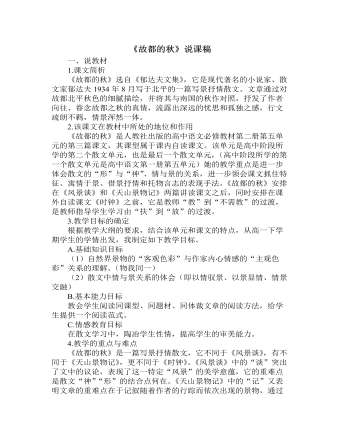
《故都的秋》说课稿(一) 2021-2022学年统编版高中语文必修上册
1.圈点、勾画重要词语评点的读书习惯和方法。如全出描绘秋色的词语,标出传递秋声的词语,点评北国故都秋色的词语、南国秋色的词语,摄取主要信息。2.口、耳、手、脑并用的读书习惯和方法。如默读、听读、跟读时,不动笔墨不看书,不动思维不读书。3.学以致用的迁移运用方法。如投影仪的练习设计,让学生由品文到品读诗词等。四、说教学程序(一)导语激趣人们常说,良好的开端是成功的一半,因而导语也就显得十分重要。好的导语能营造适宜的课堂氛围,集中学生的注意力,调动学生的学习情绪,使学生对学习的内容产生浓厚的兴趣。这篇课文的导语我是这样来设计的:同学们,自古诗家多爱秋,因为秋是文人心中的一粒愁种子。“无边落木萧萧下,不尽长江滚滚来。”这是杜甫面对秋风登高而抒怀;“梧桐更兼细雨,到黄昏,点点滴滴。这次第,怎一个愁字了得。”这是李清照面对秋雨而吟咏愁情。秋风秋雨愁煞人啦。
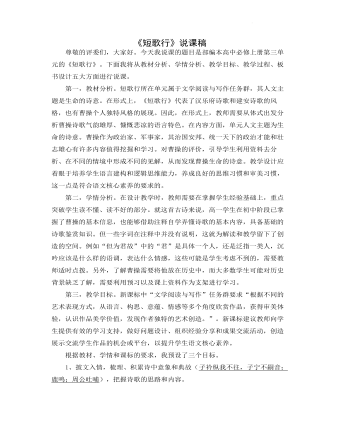
《短歌行》说课稿2022-2023学年统编版高中语文必修上册
第二课时为知人。即利用预习所查到的资料、学生之间的分享以及教师预备的材料,合作探究三个问题:曹操为何如此渴望贤才?天下归心的愿望是否实现?如何评价曹操?本课时采用创设情境的方式,从刘备、曹丕、晚年曹操等多重角度评价曹操,自领角色,利用资料有逻辑地证明自己的观点。教师出示不同学者评价,师生共同研讨评价的技巧和原则,尝试写作短小文学评论。这是解决忧的果。第三课时为回味。创设诵读比赛的情境,在比赛和评价中研讨标点符号的作用,如何读出曹操诗歌独特的特点,以及带着对曹操的认识读出自己的理解。(每组评出最佳朗读者和最佳评论员,上传优秀视频)。这是为了让学生最后读出忧。第五,板书设计。以上是我本节课教学设计的板书,体现了分析本首诗的基本思路和学习方法。
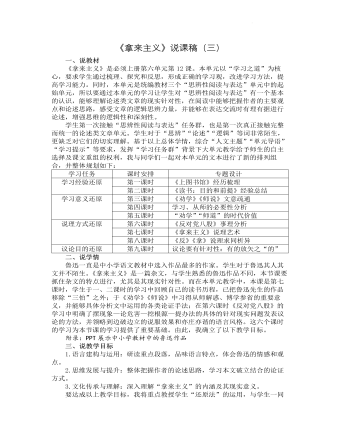
《拿来主义》说课稿(三) 2021-2022学年统编版高中语文必修上册
学生展示:鲁迅在《拿来主义》讨论“送去主义”时使用的不是徐、刘二人欧洲巡展的事实,而是《大晚报》评价二人欧洲巡展为“发扬国光”这一事实,故用了“叫作”,且是加引号的“发扬国光”;用“送”字表明自己针对的对象不是梅兰芳本人及其艺术,而是“送梅兰芳博士到苏联去”的人及其行为,即强行将中国戏剧与象征主义相联系的牵强附会的行径。可见,鲁迅针对的是当时国民政府一味送去的行径和主流媒体宣扬为“发扬国光”的舆论导向。设计意图:有的放矢,针砭时弊是杂文的突出特征。耙子指向哪儿、时弊是什么是必须思考的问题。有学生误以为鲁迅在批判徐悲鸿、刘海粟、梅兰芳等人,甚至调侃说鲁迅“怼人狂魔”“老阴阳师”。通过此活动,细读文本,还原历史,抓住“叫作”与“送”的主体,找准鲁迅批判的对象和针对的现象。同时,引导学生用不可随意使用所谓网络“梗文化”来消解名人、伟人等事迹的严肃性,不可以娱乐心态品读经典作品。
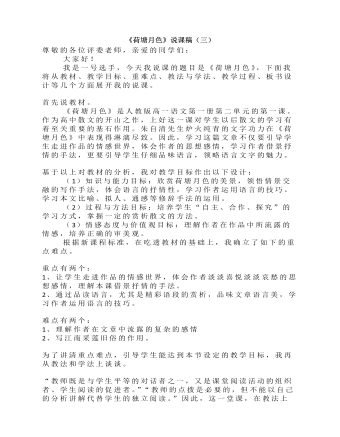
《荷塘月色》说课稿 (三)2022—2023学年统编版高中语文必修上册
环节二,在品读过程中把重点字词的读音和意义融入其中。这是新课程标准的体现环节三,提出问题:作者的思想情感在文中是怎样变化的?让学生带着这个问题再次自读课文。三、仔细品读,把握感情。引导学生去把握全文的感情基调,解决刚才提出的问题。 赏析语段,品味语言,在把握全文感情基调的基础上,启发学生联想,假设眼前有一片荷塘,设问学生会看到什么?很自然会看到:叶,花,闻到花香。在此基础上逐步引导学生赏析课文精彩语段四、五自然段,当然教师要作必要的启发指点,尤其是在那些容易被忽略之处,以下仅举一例: 荷香与歌声有什么可比的共同点?(领会通感手法的运用)在点拨通感这一修辞手法时,我举了诗人艾青描写日本著名指挥家小泽征尔的话:“你的眼睛在,你的耳朵在倾听。”这个例子能诗意的解释通感这一修辞手法。
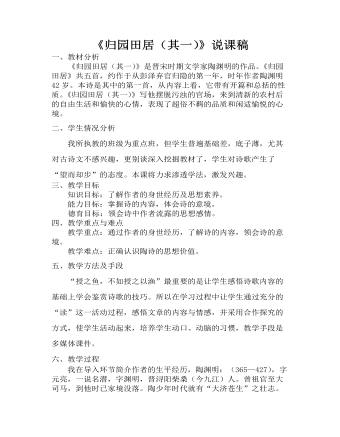
《归园田居(其一)》说课稿 2021-2022学年统编版高中语文必修上册
运用比较法,让学生讨论比较字词改换后与原诗在表达效果上有何异同,然后教师和同学们共同总结出原诗中的画线字词主要运用了比喻和拟人等修辞手法,显得既生动又含蓄,富有意境美,而改后的字词显得直白而又重复。通过文本研读部分的学习,学生对诗歌内容有了较深入的理解,为了使学生拓宽知识面,加强思想价值观的教育引导,在拓展练习部分我设置了一个探究性的问题,让学生谈谈如何看待陶渊明归隐的问题,我采用合作探究法,让学生分组互动讨论、自由发言。教师针对学生的发言,及时地加以点拨:陶渊明不与统治者合作,令人敬佩;歌唱田园风光,令人赞叹;归隐田园有独善其身,消极避世因素,这一点自然不应当苛求古人。

《百合花》说课稿 2021-2022学年统编版高中语文必修上册
1. 厘清全文的线索、情节,体会小说结构严谨、清新俊逸的写作风格。2. 分析通讯员、新媳妇的人物形象,通过品味生动的细节来感知人物身上洋溢的人性美、青春美。3.通过自主、合作、探究,从不同角度和层面发掘“百合花”这一主题的独特意蕴。4.通过把握小说人性美、青春美的主题,引导学生提升自身的精神品质和道德情操。教学重点是:通讯员及新媳妇的性格特征分析,小说如何通过细节描写来塑造人物性格。教学难点是:从不同角度和层面发掘“百合花”这一主题的独特意蕴。【教学方法】本文篇幅较长,但我们决定用一个课时来完成教学任务,课前让学生充分预习文本,自己搜集有关“百合花”的知识资料,自主梳理文章的故事情节,自主归纳人物的形象、性格特点。课堂上采用情景激趣法、启发诱导法、合作探究法等教学方法来引导学生学习探究,培养学生的文学鉴赏能力。
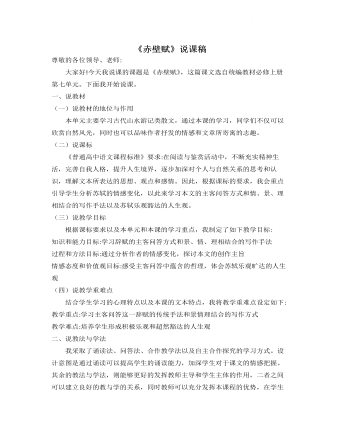
《赤壁赋》说课稿 2021-2022学年统编版高中语文必修上册
(三)赏析课文,品味哲理此环节重在解决本课的重点难点。首先,我运用问答法解决1.2两个问题。问答可以吸引学生注意,激发学生思维,培养学生概括和说话能力。通过学生的回答,即“固一世之雄也,而今安在哉”和“哀吾生之须臾,羡长江之无穷”以及“挟飞仙以遨游,抱明月而长终”这三个句子,最后明确答案:古今历史对比生悲、人生短暂和自然无穷对比生悲、理想与现实矛盾生悲;再以同样的方式分析第4段,通过教师提出问题,学生进行思考和回答这一过程,归纳出“水与月”、“变与不变”和“自然之无尽藏也”这三层哲理,最后得出是苏轼超然洒脱、乐观旷达的人生观劝慰了客人,从而达到第5段中“客喜而笑”的结果。设计两个问题的意图是让学生得以把握苏轼由疑惑沮丧到豁然开朗这一情感变化,从而更好的赏析本文。
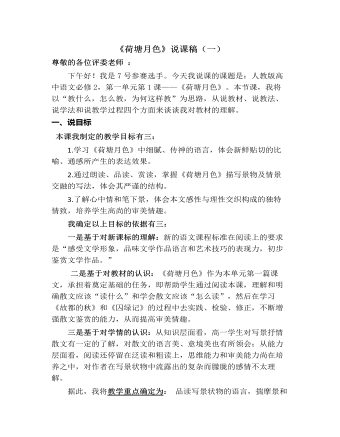
《荷塘月色 》说课稿(一) 2021-2022学年统编版高中语文必修上册
一、说目标本课我制定的教学目标有三:1.学习《荷塘月色》中细腻、传神的语言,体会新鲜贴切的比喻、通感所产生的表达效果。2.通过朗读、品读、赏读,掌握《荷塘月色》描写景物及情景交融的写法,体会其严谨的结构。3.了解心中情和笔下景,体会本文感性与理性交织构成的独特情致,培养学生高尚的审美情趣。我确定以上目标的依据有三:一是基于对新课标的理解:新的语文课程标准在阅读上的要求是“感受文学形象,品味文学作品语言和艺术技巧的表现力,初步鉴赏文学作品。”二是基于对教材的认识:《荷塘月色》作为本单元第一篇课文,承担着奠定基础的任务,即帮助学生通过阅读本课,理解和明确散文应该“读什么”和学会散文应该“怎么读”,然后在学习《故都的秋》和《囚绿记》的过程中去实践、检验、修正,不断增强散文鉴赏的能力,从而提高审美情趣。
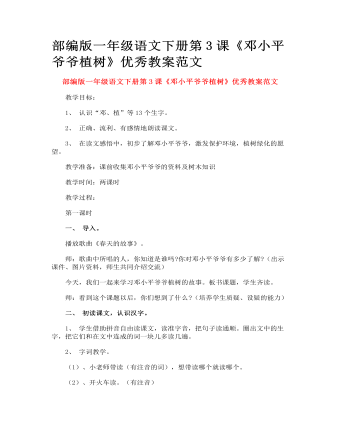
部编版一年级语文下册第3课《邓小平爷爷植树》优秀教案范文
读文感悟。 1、出示:邓小平爷爷( )地种柏树。 师:同学们带着这个问题仔细读课文,用“——”划出有关句子。然后想一想,“( )”里填什么词比较恰当。 2、生自由读课文,边读边划。 3、 全班汇报交流。 师:你认为邓小平爷爷( )地种柏树,从哪些地方体现出来? (以读为主,引导学生学会读课文,尊重学生个性化的理解。“( )”里可填“起劲、仔细、认真、一丝不苟、小心”等等,随机进行读文,结合语言文字训练,体会邓小平爷爷积极为祖国绿化作贡献的精神。) (如:找出邓小平爷爷种树的动作词“挖、挑选、移、填、站在、扶正”,同桌伙伴,一人做动作,一人口述植树过程。“移”字可换“放”字比较理解。) 4、 四人小组讨论:邓小平爷爷为什么种树?他是怎么想的? (结合课前收集的邓小平爷爷的资料理解,体会邓小平爷爷一心为国之心,激发学生参与绿化的热情。)

新人教版高中英语必修3Unit 3 Diverse Cultures-Discovering Useful Structure教学设计
Step 4 PracticeRead the conversation. Find out which words have been left out.Justin: Linlin, I’m going to Guizhou Province next month. I’m super excited! Any recommendations for places to visit?Linlin: Wow, cool! Guizhou is a province with a lot of cultural diversity. Places to visit...well, definitely the Huangguoshu Waterfall first.Justin: What’s special about the waterfall?Linlin: Well, have you ever heard of the Chinese novel Journey to the West ?Justin: Yes, I have. Why ?Linlin: In the back of the waterfall, you will find a cave, which is the home of the Monkey King.Justin: Really? Cool! I’ll definitely check it out.Linlin:And I strongly recommend the ethnic minority villages. You’ll find Chinese culture is much more diverse than you thought.Justin:Sounds great, thanks.Answers:Justin: Linlin, I’m going to Guizhou Province next month. I’m super excited! Do you have any recommendations for places to visit?Linlin: Wow, that’s cool! Guizhou is a province with a lot of cultural diversity. What are some places to visit in Guizhou ? Well, definitely the Huangguoshu Waterfall is the first place to visit in Guizhou Province.Justin: What’s special about the waterfall?Linlin: Well, have you ever heard of the Chinese novel Journey to the West ?Justin: Yes, I have heard of the Chinese novel Journey to the West . Why do you ask if I have heard of the Chinese novel Journey to the West?Linlin: In the back of the waterfall, you will find a cave, which is the home of the Monkey King from Journey to the West.Justin: That’s really true? It’s Cool! I’ll definitely check it out.Linlin:And I strongly recommend the ethnic minority villages on your trip to Guizhou Province. You’ll find Chinese culture is much more diverse than you thought it was.Justin:This all sounds great, thanks.
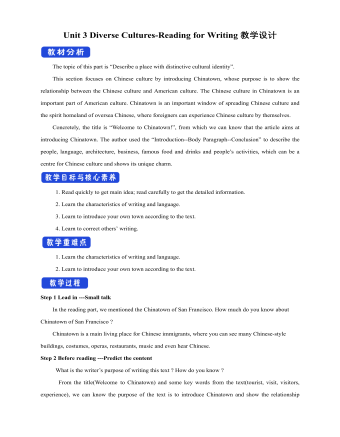
新人教版高中英语必修3Unit 3 Diverse Cultures-Reading for Writing教学设计
The topic of this part is “Describe a place with distinctive cultural identity”.This section focuses on Chinese culture by introducing Chinatown, whose purpose is to show the relationship between the Chinese culture and American culture. The Chinese culture in Chinatown is an important part of American culture. Chinatown is an important window of spreading Chinese culture and the spirit homeland of oversea Chinese, where foreigners can experience Chinese culture by themselves.Concretely, the title is “Welcome to Chinatown!”, from which we can know that the article aims at introducing Chinatown. The author used the “Introduction--Body Paragraph--Conclusion” to describe the people, language, architecture, business, famous food and drinks and people’s activities, which can be a centre for Chinese culture and shows its unique charm.1. Read quickly to get main idea; read carefully to get the detailed information.2. Learn the characteristics of writing and language.3. Learn to introduce your own town according to the text.4. Learn to correct others’ writing.1. Learn the characteristics of writing and language.2. Learn to introduce your own town according to the text.Step 1 Lead in ---Small talkIn the reading part, we mentioned the Chinatown of San Francisco. How much do you know about Chinatown of San Francisco ?Chinatown is a main living place for Chinese immigrants, where you can see many Chinese-style buildings, costumes, operas, restaurants, music and even hear Chinese.Step 2 Before reading ---Predict the contentWhat is the writer’s purpose of writing this text ? How do you know ?From the title(Welcome to Chinatown) and some key words from the text(tourist, visit, visitors, experience), we can know the purpose of the text is to introduce Chinatown and show the relationship between Chinese culture and American culture.
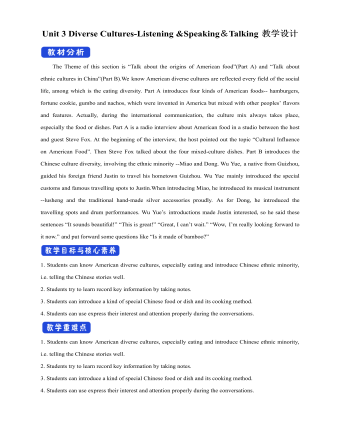
新人教版高中英语必修3Unit 3 Diverse Cultures-Listening &Speaking&Talking教学设计
1. In Picture 1 and Picture 2, where do you think they are from? How do you know?From their wearings, we can know they are from ethnic minority of China--- Miao and Dong.Picture 1, they are playing their traditional instrument lusheng in their traditional costumes.Picture 2. the girls are Miao because they wear their traditional costumes and silver accessory.2. In Picture 3, can you find which village it is? What time is it in the picture?It is Dong village. It is at night. Step 2 While-listeningJustin met a new friend while traveling in Guizhou. Listen to their conversation and complete the summaries below.Part 1Justin and Wu Yue watched some Miao people play the lusheng. The instrument has a history of over 3,000 years and it is even mentioned in the oldest collection of Chinese poetry. Then they watched the lusheng dance. Justin wanted to buy some hand-made silver/traditional accessories as souvenirs. He was told that the price will depend on the percentage of silver. Part 2They will go to a pretty Dong minority village called Zhaoxing. they will see the drum towers and the wind and rain bridges. They may also see a performance of the Grand Song of the Dong people.Step 3 Post-listening---TalkingWork in groups. Imagine Justin is telling some friends about his trip to Guizhou. One of you is Justin and the rest of you are his friends. Ask Justin questions about his trip and experience. The following expressions may help you.
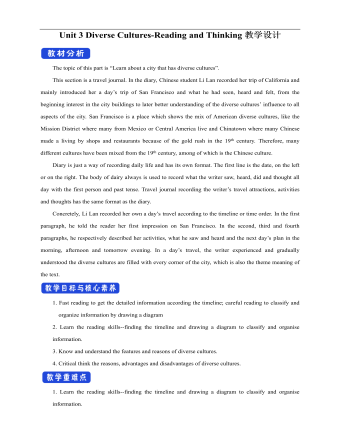
新人教版高中英语必修3Unit 3 Diverse Cultures-Reading and Thinking教学设计
Discuss these questions in groups.Q1: Have you ever been to a place that has a diverse culture ? What do you think about the culture diversity ?One culturally diverse place that I have been to is Harbin, the capital city of Heilongjiang Province. I went there last year with my family to see the Ice and Snow Festival, and I was amazed at how the culture as different to most other Chinese cities. There is a big Russian influence there, with beautiful Russian architecture and lots of interesting restaurants. I learnt that Harbin is called “the Oriental Moscow” and that many Russians settled there to help build the railway over 100 years ago.Q2: What are the benefits and challenges of cultural diversity ?The benefits: People are able to experience a wide variety of cultures, making their lives more interesting, and it can deepen the feelings for our national culture, it is also helpful for us to learn about other outstanding culture, which helps improve the ability to respect others. The challenges: People may have trouble communicating or understanding each other, and it may lead to disappearance of some civilizations and even make some people think “The western moon is rounder than his own.”Step 7 Post reading---RetellComplete the passage according to the text.Today, I arrived back in San Francisco, and it feels good (1) _____(be) back in the city again. The city succeeded in (2)_________ (rebuild) itself after the earthquake that (3)________ (occur) in 1906, and I stayed in the Mission District, enjoying some delicious noodles mixed with cultures. In the afternoon, I headed to a local museum (4)____ showed the historical changes in California. During the gold rush, many Chinese arrived, and some opened up shops and restaurants in Chinatown to earn a (5)_____ (live). Many others worked on (6)______ (farm), joined the gold rush, or went to build the railway that connected California to the east. The museum showed us (7)____ America was built by immigrants from (8)________ (difference) countries and cultures. In the evening, I went to Chinatown, and ate in a Cantonese restaurant that served food on (9)________(beauty) china plates. Tomorrow evening, I’m going to (10)__ jazz bar in the Richmond District. 答案:1. to be 2. rebuilding 3. occurred 4. that 5.living6. farms 7.how 8. different 9. beautiful 10. a

新人教版高中英语必修3Unit 4 Space Exploration-Reading For Writing教学设计一
另一方面,其余的人反对这个计划,因为它可能会导致一些不好的影响。7.I hold the belief that space exploration not only enable us to understand how the universe began but also help us survived well into the future.我坚信探索太空不仅能够使我们了解宇宙的起源而且能够帮助我们更好地走进未来。8.I think we should spend more time and money exploring space so as to provide new and better solutions to people's shortterm and longterm problems.为了给人类的短期和长期问题提供更新和更好的解决方法,我认为我们应该花更多的时间和金钱来探索太空。9.From my point of view,it is wrong of young people to depend on their telephones too much,which may do harm to both their physical and mental health.在我看来,年轻人过度依赖手机是不对的,因为它们可能会对他们的身心健康都有害。最近你班同学就“人类是否应该进行宇宙探索”这个问题进行了激烈的讨论。有人认为,探索宇宙不仅让人类更好地了解宇宙的发展,还可以用来指导农业生产,以及把一些探索太空的高新技术用于现实生活;也有一些人认为探索太空花掉了大量的人力物力;影响了人们的生活水平。请你根据以下情况写一篇报告并发表自己的观点。注意:1.写作内容应包括以上全部要点,可适当发挥,使上下文连贯;
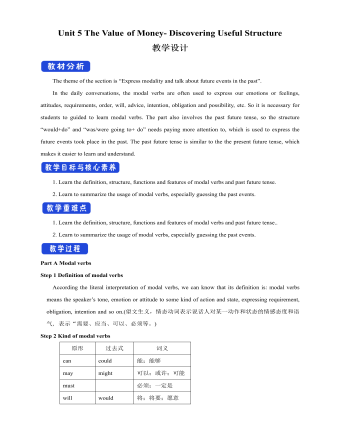
新人教版高中英语必修3Unit 5 The Value of Money- Discovering Useful Structure教学设计
Step 3 Meaning1. 过去将来时表示从过去某一时间来看将要发生的动作或存在的状态, 常用在宾语从句中。一般由“would/should +动词原形”构成。She hoped that they would meet again someday. 她希望将来有一天他们能再见面。2. was/were going to+动词原形: 表示过去将要发生或很有可能发生的动作, 常用于口语中, 表示预言、意图或者打算等。He was going to start work the following week. 他打算下星期开始工作。3. was/were about to do: 常用来表示即将发生的动作, “刚要/正要做……”。注意该结构不与任何时间状语连用。I felt that something terrible was about to happen. 我感到某种可怕的事情即将发生。4.was/were to do: 表示“曾计划做某事”, 如果表示“本来计划做某事, 动作没实现”, 则需用 “was/were to have done”。She said she was to have told me about the accident. 她说她本来想告诉我关于事故的事。5.Start, go, come, leave, see, meet等动词的过去进行时: 表示就过去某一时刻而言即将发生的动作。She was coming later. 她随后就来。I had just put on my overcoat and was leaving to visit a friend of mine. 我刚穿上外套要去看我的一个朋友。

新人教版高中英语必修3Unit 1 Festivals and celebrations-Discovering Useful Structure教学设计
4.That was an experience that frightened everyone. →That was _____________________. 答案:1. taking 2. being discussed 3. in the reading room 4. a frightening experienceStep 6 The meaning and function of V-ing as the predicative动词-ing形式作表语,它通常位于系动词后面,用以说明主语“是什么”或“怎么样”一种表示主语的特质、特征和状态, 其作用相当于形容词; 另一种具体说明主语的内容, 即主语等同于表语, 两者可互换。The music they are playing sounds so exciting. 他们演奏的音乐听起来令人激动。The result is disappointing. 结果令人失望。Our job is playing all kinds of music. 我们的工作就是演奏各种音乐。Seeing is believing. 眼见为实。Step 7 Practice1. It is ________(amaze) that the boy is able to solve the problem so quickly.2. Buying a car is simply _______(waste) money. 3. Please stop making the noise—it’s getting ________(annoy). 4. complete the passage with the appropriate -ing form.La Tomatina is a festival that takes place in the Spanish town Bunol every August. I think many food festivals are __________ because people are just eating. however, this festival is _________ because people don't actually eat the tomatoes. Instead, they throw them at each other! the number of people ________ part in this tomato fight, can reach up to 20,000, and it is a very __________ fight that lasts for a whole hour. The _______ thing is how clean Bunol is after the tomatoes are washed away after the fight. this is because the juice form tomatoes is really good for making surfaces clean!答案:1. amazing 2. wasting 3. annoying4. boring interesting taking exciting amazing

新人教版高中英语必修3Unit 1 Festivals and Celebrations-Reading and Thinking教学设计
The topic of this part is “Discover the reasons for festivals and celebrations.The Listening & Speaking & Talking part aims at talking about the experiences and feelings or emotions about the festivals and celebrations. This section aims at detecting the reason why the people celebrate the festivals, the time, the places, the types and the way of celebrations. It also explains why some traditions in the old celebrations are disappearing, like the firecrackers in the big cities and some new things are appearing like the prosperity of business or commerce. 1. Students can talk about what festivals they know and the reasons and the way of celebrating them.2. Students should learn the reading skills such as the headline and get the topic sentences, the structures of articles.3. Students can understand the past, the present situation of some festival around the world and why there are some changes about them. 4. Students can have the international awareness about the festivals.1. Students should learn the reading skills such as the headline and get the topic sentences, the structures of articles.2. Students can understand the past, the present situation of some festival around the world and why there are some changes about them.Step 1 Lead in---Small talkWhat festival do you like best ? Why ?I like the Spring Festivals because I can set off the fireworks, receive the lucky money and enjoy the Gala with my families.Step 2 Before reading---Pair workWhy do people celebrate different festivals ?The Spring Festivals is to celebrate the end of winter and the coming of spring and new life.The Mid-autumn Day is to celebrate the harvest and admire the moon.

新人教版高中英语必修3Unit 1 Festivals and Celebrations-Listening &Speaking&Talking教学设计
The theme of this section is “Talk about festival activities and festival experiences”.Festival and holiday is a relaxing and interesting topic for students. This part talks about the topic from the daily life of students’. In the part A ---Listening and Speaking, there are three conversations among different speakers from three countries(Japan, Rio and China), where the speakers are participating in or going to participate in the festivals and celebrations. So listening for the relationship among them is a fundamental task. Actually, with the globalization and more international communication, it is normal for Chinese or foreigners to witness different festivals and celebrations in or out of China. In the Conversation 1, a foreign reporter is interviewing a Japanese young girl who just had participated in the ceremony of the Coming-of-Age Day on the street and asking her feeling about the ceremony and the afterwards activities. Conversation 2, Chinese girl Li Mei is witnessing the Rio Carnival for the first time, and her friend Carla gives her some advice on the costumes which enables her to match with the carnival to have a good time. Conversation 3, a Chinese guide is showing a group of foreign visitors around the Lantern Festival and introducing the customs of the festival to them. The three conversations have a strong vitality and insert the festival and cultural elements from different countries. So perceiving the festivals and cultures from different countries is the second task. At the same time, the scripts also insert the targeted grammar --- v-ing as attributive and predicative, which students can perceive and experience in a real context and make a road for the further study. That is the third task. In the Part B--- Listening and Talking, the theme is “Talk about festival experience”, which is the common topic in our daily conversations. During the conversation, Song Lin, a Chinese student, asked Canadian friend Max about how to spend Christmas. In the conversation, Song Lin talked about experience and the feelings during the Chinese Spring Festival, during which there are not only some enjoyable things but some unpleasant things. After the listening, perhaps students find there are some similarities between Christmas and the Chinese Spring Festival as there are some differences in the origins and celebrations. For example, people always visit friends and relatives, decorate their houses, have a big dinner together, chat and give presents to each other.